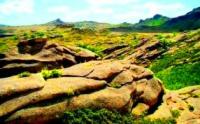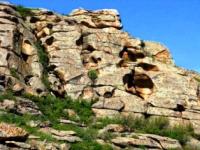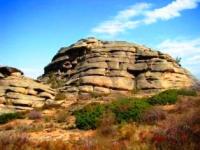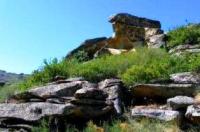You are here
Delbegethey mountains on Altai.





A trip to mountains East-Kazakhstan.
“Fear of vultures, one-eyed rati of the arimasp. Don’t come close to them!”
Aeschylus.
Traveling in mountains of East Kazakhstan region.
This granite massif, rich in deposits of precious and semiprecious stones, has long attracted the attention of both lovers of mysteries and quite traditional scientists - historians, archaeologists, local historians and geologists. There are two versions of the origin of the name Delbegethei.
The first is from the word “dragon”, and this name of the mountain is fully justified, since earlier there were really huge creatures - dinosaurs. In the quartz sand of the Zaisan depression, our scientists found bones and shells of eggs of dinosaurs.
This discovery in 1959 was a sensation for scientists of the Soviet Union, such a discovery was discovered for the first time in our then very large country. The deposition of fossils in Zaysan is called the "dinosaur." The second version says that Delbeghetei, translated from ancient Chinese, means "grateful, supportive, well-meaning" - in honor of the great natural wealth of the area.
Modern research has shown that it was here that the ancient miners mined tin, emerald, semi-precious aquamarine and transparent beryl. By the way, these miners were considered representatives of the ancient legendary Chud tribe, who had the skills of mining and metallurgy.
The Bukhtarma Old Believers and the Irtysh Cossacks - the Russian first settlers of Altai - called the ancient mines in the places of the Delbegetian ore mining "Chudsky holes." The “Miracle” in their concept was alien, alien, incomprehensible, because the memory of the most ancient metallurgists was so covered by the dust of centuries that, apart from the general “chud”, little remained.
True, there are preserved names in some places: the Churchchut river near Lake Alakol, the tract and the river Chur-chutsu in the Narym region. They only confirm the antiquity of the first settlers of these places.
But modern scholars believe that a chud is actually representatives of the Andronovo tribes known to us from the history of Kazakhstan. And some archaeologists believe that the Andronovites are the very legendary Aryans - the Aryans, some of whom went to India in the II millennium BC.
E. S. Chernikov, who devoted his whole life to the study of Andronovites - plowmen, pastoralists, metallurgists - identified them with the Arimasp of Herodotus. Aeschylus wrote of them: “Fear the vultures, the one-eyed rati of the Arimaspians.
Don’t come close to them!” From the train connecting Semipalatinsk - Almaty, on the seventieth kilometer from Semipalatinsk, mountains are visible on the left side. These mountains are not very high. The largest peak is about 750 meters above sea level.
But they are so beautifully located and have so many options for all kinds of gorges, valleys, branches that the diversity inside Delbegethei is simply amazing. There is not a single valley or gorge similar to each other. In the mountains there are cave paintings - "petroglyphs" of an ancient person, reflecting the hunting of animals and life of that time.
Still in the mountains there are springs, of which crystal clear and tasty water beats. The mountains of Delbogethey are rich in their minerals. There are ancient pits (caves) where tin was mined. They are already several thousand years old.
S. Chernikov, who devoted his whole life to the study of Andronovites - plowmen, cattle breeders, metallurgists - identified them with the Arimaspas of Herodotus. Aeschylus wrote of them: “Fear the vultures, the one-eyed rati of the Arimaspians.
Don’t come close to them! ” This mountain range is rich in wildlife. There are many birds and ornithologists often study their attendance. At present, there are peasant farms around and around Delbegethey, which in the summertime also abound with rich and juicy herbs, which are so necessary for livestock.
Authority:
Official site of the Semipalatinsk deanery. Ust-Kamenogorsk and Semipalatinsk diocese of the Metropolitan Okrug of the Russian Orthodox Church in Kazakhstan. Newspaper "Megapolis", author: Gulsum Kunelekova.
Photos
Alexander Petrov.







